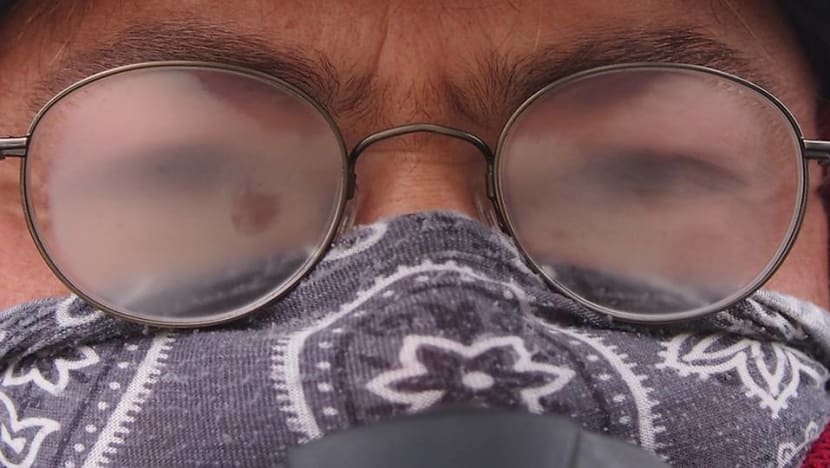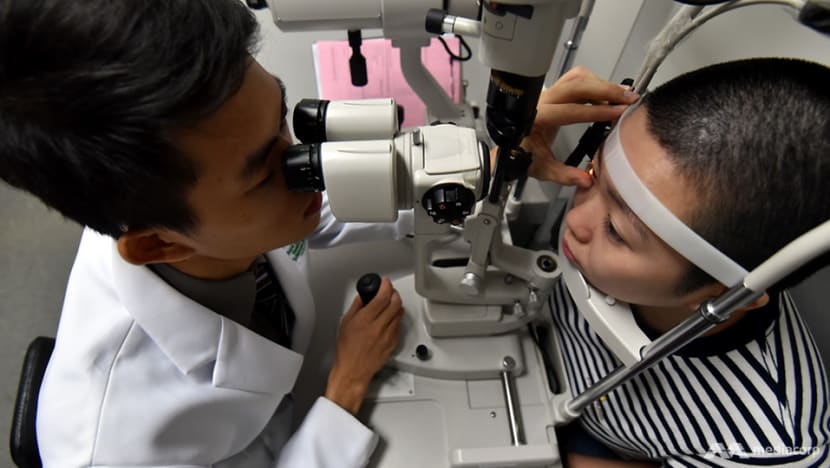How working from home is resulting in more eyesight problems

Working from home may not be easy on your eyes. (File photo: iStock)
SINGAPORE: The work-from-home arrangement that has been the default way of life for many employees during the COVID-19 pandemic has not been easy on the eyes for some people.
Less-than-ideal home offices, blurred boundaries between work and home, and fewer breaks from screen time – these are some issues contributing to digital eye strain and "eye floaters", or spots in a person's vision, eye doctors told CNA.
When working from home, there is a lack of scheduled time away from the screen, said Dr Wesley Chong of the Singapore National Eye Centre.
“While a lunch break in the past used to involve heading out with colleagues and giving the eyes some rest from the screen, work-from-home arrangements have reduced this to additional screen time on the phone instead,” said Dr Chong, who is a consultant in the cataract and comprehensive ophthalmology department.
The work-from-home environment may also not be ergonomically optimised for prolonged computer work. Employees may be using smaller screens and possibly inadequate lighting, he said.
Another issue is that without "fixed" hours that come with working in the office for many, people may be working more, said Dr David Chan, senior consultant eye surgeon at Atlas Eye Specialist Centre.
“When working from home, the boundary between work-life balance can get blurred when working on digital devices including work laptops are within convenient reach. This can cause an ‘overtime’ for the eyes which can significantly impact visual health,” said Dr Chan, who is also the centre’s medical director.
The doctors added that work communication that would have been conducted face-to-face now have to be done virtually, increasing overall screen time. Screen time is again lengthened when people use their gadgets or watch television for leisure, they said. These changes have led to eyesight-related problems, they said.
THE EYE PROBLEMS
Dr Chan said his centre saw a 20 per cent increase – between June 2020 and May this year – in the number of people with complaints of eye fatigue, dry eyes and floaters.
While concentrating on work without proper breaks, people blink less frequently, which can cause dry eyes, he said.
He said that incomplete blinks are also more prone to occur. For people who work on-site, wearing masks has also increased the incidence of dry eyes with air flowing over the eyes from the tops of masks, he said.
Tired eyes are usually caused by working in an environment with inadequate or overly bright overhead lighting and reading text in smaller font sizes on smaller screens, he added. Those working with screens that have bright and uniform backgrounds – like word documents and spreadsheets – tend to experience floaters more frequently, he said.
Dr Errol Chan, a consultant at the LSC Eye Clinic, said he saw a 35 per cent increase in the number of adults with digital eye strain shortly after the start of each “shutdown” period.
While the increase was “particularly marked” during the "circuit breaker" period when working from home was first mandated, he said there continued to be a rise during more recent restrictions.
The eye strain arises from a combination of blinking less, which causes the cornea to dry out and results in blurry vision, and focusing up close for prolonged periods of time, which tires out the tiny focusing muscles of the eyes, he said.
SPECTACLE FREEDOM
The doctors reported an increase in the number of people seeking to stop wearing spectacles.
Dr David Chan said his centre saw a 20 per cent increase in the number of patients seeking “spectacle independence” due to challenges posed by mask-wearing and longer screen times.
Similarly, Dr Natasha Lim, who runs an eye clinic in her name, said she has seen a 20 per cent increase in the number of patients opting for surgery to remove the need for spectacles.
“The wearing of masks causes glasses to suffer condensation and blurs vision, so spectacle wearers have to constantly remove their glasses and wipe them. Hence, they start to consider refractive surgery to gain spectacle freedom,” she said.

Other than mask-wearing, people may also be motivated to have corrective surgery by other factors such as more time and cash since they are not able to travel, she said.
Dr Chong, however, said that the issue of masks fogging up can be “easily remedied” by ensuring that the mask fits securely over the nose.
“A mask with a nose bridge will prevent warm air from escaping upwards and forming condensation on the cooler surface of the glasses," he said. Those who have difficulty finding a mask with a suitable fit can also consider taping the bridge of the nose down with medical tape to ensure a better seal, he suggested.
There are also changes among people who do not wear spectacles. More reusable contact lens wearers are switching to daily contact lenses, said Mr Vaibhav Saran, Johnson & Johnson Vision’s area vice-president for Vision Care in Asia Pacific, citing a report done by his firm.
“Increased comfort from daily contact lenses meant wearers are less likely to rub their eyes. Hence, this reduces the risk of introducing dirt and bacteria into their eyes,” he said.
EFFECTS ON STUDENTS
Children and students have not been spared, the experts said.
Ms Chui Wen Juan, vice-president of the Singapore Optometric Association, said that optometrists have seen an increase in the number of children having to wear spectacles.
“We see many children with a significant increase in myopia, probably also due to more classes on home-based learning, but perhaps also delayed visits to the optometrist because school health screenings were temporarily suspended,” she said.
A lack of outdoor activity could also cause children's myopia to worsen.
“Whether screen time per se indeed impacts on myopia progression is not clear at this point,” LSC Eye Clinic's Dr Errol Chan.
“What is probably logical is that a change in activity profile with kids being indoors more often, to the extent of exclusion of all outdoor activity, is not conducive to preventing myopia progression."

HOW TO PROTECT THE EYES
The experts suggested resting the eyes, blinking and placing devices correctly as some ways to protect the eyes.
“Rest the eyes from the screens by looking into the distance (minimum 3m or further) for 20 seconds every 20 minutes,” Ms Chui said.
Singapore National Eye Centre's Dr Chong suggested setting the computer screen five to 40 degrees below your horizontal line of sight, and about 2ft away – the optimal position for both eye and neck comfort.
To prevent eyesight from worsening, he suggested spending more time outdoors and treating existing myopia.
Dr Lim noted that the rate of blinking automatically reduces from blinking every 15 seconds to every two to three minutes when in front of computer screens or handphones, and said people should remind themselves to blink.
She added that they should use artificial tear lubricants to moisturise and maintain a healthier corneal surface. She cautioned against allowing the eyes to run dry which could lead to “blurrer” vision.
She likened the eyes to skin.
“If you don't look after dry skin condition, you will have more wrinkles when you are older. By moisturising dry skin, you can maintain healthier and better-looking skin. Similarly, by preventing and treating dry eye conditions, you will enjoy better quality vision as you age,” she said.















